|
Lear's Darker Purpose
PERIODS 2-3
Text One – “Meantime we shall express our darker purpose” (Act 1, Scene 1, ll. 36-122)
BEFORE READING ACTIVITY
LEAR’S “DARKER PURPOSE” (10 min.)
AIM: To provide a visual aid to the scene which generates all subsequent action; to introduce Lear ’s “darker purpose” as the beginning of his tragedy: it is the king’s decisions that set his tragedy in motion. PROCEDURE: the teacher hands out the following drawing and introduces it as a sketch of the opening scene of the play. This activity may be run as a whole class one: after handing out the drawing, and pre-teaching new vocabulary (e.g. step down = to resign), the teacher prompts his/her students with the following topics and gets an oral feedback.
Look at this drawing and say:
1.Who the characters are and how they are related
2.What the king does or intends to do
3.Whether the king’s decision is good or not
4.What assumptions are exploited in relation to monarchy. What are the duties of a king or a queen? Can a king legitimately “step down”? What might happen if a king is deposed?
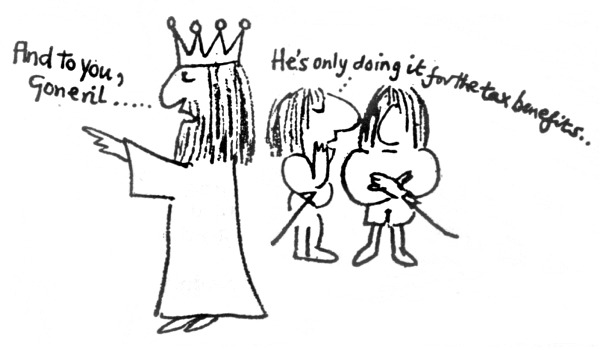
KEYS 1.They are a king and two of his knights (we recognize them by their swords). There are also characters not drawn but hinted at: “And to you, Gonerill…” (students try to guess who she is).
2.Students guess what the king intends to do. Correct answer: the king intends to divide his kingdom. The knights make (ironical) comments on his decision.
3.The knight’s comment “He’s only doing it for the tax benefits…” suggests that the king’s decision is not good.
4.A king or queen must rule till death. A king can’t legitimately resign. If a king is deposed, his succession might become insecure and cause wars.
WHILE-READING ACTIVITY
ACTION SPEAK LOUDER THAN WORDS (20 min.)
AIM: To give the students a purpose for reading, to create expectations about what is coming next, to focus on the theme of flattery and its dangers, to focus on Lear’s dysfunctional family. PROCEDURE: this activity may be run as a small group work. The teacher models the “think aloud strategy” using the scene between Gloucester, Kent and Edmund (Act I, Scene I, lines 1-35). The “Think aloud strategy” enables the students to see that it is completely reasonable to have difficulties and problems with meaning, when reading Early Modern English. The teacher is able to show how he/she uses the text’s glossary and how he/she works out the meaning and highlights potentially significant passages by making his/her thinking audible to the students. He/she asks them to read the passage aloud and stop at any point with a question (e.g. “Which of the two Dukes does Kent suggest Lear prefers?”; “Who is older, Edmund or Edgar?” etc.). They may also stop it when they want to highlight a particular line or group of lines (e.g. Gloucester’s smutty jokes about Edmund, his illegitimate son “His breeding …hath been at my charge. I have so often blushed to acknowledge him that now I am brazed to it… this knave came saucily to the world…it was good sport at his making, and the whoreson must be acknowledged” , ll. 8-23). Students should do this quite actively, following the model the teacher had already provided. The teacher can appoint one group to be the glossary.
Read the text and find out:
1.Why and how Lear gives up his kingdom.
2.What is wrong with Lear’s method of assessing his daughters’ love.
3.Why Cordelia can’t express her love.
4.Why Lear insists on having Cordelia’s declaration of love.
KEYS
1.Reaching old age and desiring a quiet life without the responsibilities and cares of state, King Lear decides to divide his kingdom between his three daughters, Gonerill, Regan and Cordelia. He devises a “love-test” to see which daughter loves him most.
2.Love-tests are foolish, but Lear’s one is non-sense. He asks his daughters to enter a competition in which what really counts is words, not love. What Lear doesn’t seem to be aware of is that words can be deceptive, and that flattery has nothing to do with love.
3.Because she is aware that love goes beyond words.
4.Cordelia is his favourite daughter. What Lear is looking for is a reason to justify his former decision to give her the “first prize” , that is to say, the greatest part of his kingdom.
LEAR
Meantime we shall express our darker purpose .
Give me the map there. Know, that we have divided
In three our kingdom: and 'tis our fast intent
To shake all cares and business from our age,
Conferring them on younger strengths, while we
Unburdened crawl toward death. (…)
Tell me, my daughters,
Since now we will divest us both of rule,
Interest of territory, cares of state,
Which of you shall we say doth love us most?
That we our largest bounty may extend
Where nature doth with merit challenge . Gonerill,
Our eldest-born, speak first.
GONERILL
Sir, I love you more than words can wield the matter;
Dearer than eyesight, space, and liberty,
Beyond what can be valued, rich or rare,
No less than life, with grace, health, beauty, honour;
As much as child e'er loved, or father found;
A love that makes breath poor, and speech unable;
Beyond all manner of ‘so much’ I love you.
CORDELIA [ aside]
What shall Cordelia speak?
Love, and be silent.
LEAR
Of all these bounds, even from this line to this,
With shadowy forests and with champains riched ,
With plenteous rivers and wide-skirted meads ,
We make thee lady. To thine and Albany's issue
Be this perpetual. -- What says our second daughter,
Our dearest Regan, wife of Cornwall?
REGAN
I am made of the self mettle as my sister,
And price me at her worth . In my true heart
I find she names my very deed of love;
Only she comes too short, that I profess
Myself an enemy to all other joys,
Which the most precious square of sense possesses;
And find I am alone felicitate
In your dear highness' love.
CORDELIA [aside]
Then poor Cordelia!
And yet not so, since, I am sure my love's
More ponderous than my tongue.
LEAR
To thee and thine hereditary ever
Remain this ample third of our fair kingdom,
No less in space, validity , and pleasure ,
Than that conferred on Gonerill. Now, our joy,
Although our last and least , to whose young love
The vines of France and milk of Burgundy
Strive to be interessed : what can you say to draw
A third more opulent than your sisters’? Speak.
CORDELIA
Nothing, my lord.
LEAR
Nothing?
CORDELIA
Nothing.
LEAR
Nothing will come of nothing . Speak again.
CORDELIA
Unhappy that I am, I cannot heave
My heart into my mouth. I love your majesty
According to my bond , no more nor less.
LEAR
How, how, Cordelia! Mend your speech a little,
Lest it may mar your fortunes.
CORDELIA
Good my lord,
You have begot me, bred me, loved me: I
Return those duties back as are right fit ,
Obey you, love you, and most honour you.
Why have my sisters husbands, if they say
They love you all? Haply when I shall wed,
That lord whose hand must take my plight shall carry
Half my love with him, half my care and duty.
Sure, I shall never marry like my sisters,
To love my father all.
LEAR
But goes thy heart with this?
CORDELIA
Ay , my good lord.
LEAR
So young, and so untender?
CORDELIA
So young, my lord, and true.
LEAR
Let it be so! Thy truth, then, be thy dower !
For by the sacred radiance of the sun,
The mysteries of Hecat and the night;
By all the operation of the orbs
From whom we do exist, and cease to be,
Here I disclaim my paternal care,
Propinquity and property of blood,
And as a stranger to my heart and me
Hold thee from this for ever. The barbarous Scythian ,
Or he that makes his generation messes
To gorge his appetite, shall to my bosom
Be as well neighboured, pitied and relieved
As thou my sometime daughter.
KENT
Good my liege --
LEAR
Peace, Kent!
Come not between the dragon and his wrath.
 The King desired her to mend her speech. [Charles and Mary Lamb.Tales from Shakespeare.1878.]
AFTER READING ACTIVITIES
1) THE TRAGEDY OF LEAR (10 min.)
AIM: To lead students towards a deeper understanding of the text, to encourage personal response to the text and provide an opportunity for exploitation through a speaking task. PROCEDURE: This activity may be run as a class discussion. The teacher writes on the board useful words and expressions such as:
(VB): to flatter, to deceive/mislead, to trust, to reward, to banish, to disown/disinherit, to preserve, to judge by appearances, to mind the substance and not the form of things, to have grudge against s.o.
(N): flattery, honesty, paternal /filial love, love test, effort, pride, appearance, substance,
(ADJ): deceptive/deceitful, treacherous, ambitious, faithful, honest,
(ADV): truly, honestly, deceitfully, treacherously
then he/she prompts the class with the following topics and gets an oral feedback:
1.Which is the “good” daughter? Why?
2.What does Lear do that makes him a “bad” father? What is his tragic error?
3.Why is Lear’s family dysfunctional?
KEYS
Students give their personal responses. Possible answers:
1.The good daughter is Cordelia: she is the only one who doesn’t flatter her father, and truly loves him.
2.What makes Lear a “bad father” is rewarding his two treacherous daughters and banishing his faithful one. Lear’s tragic error is being compelled to trust flattery over honesty in an effort to preserve his own pride.
3.Lear’s family is dysfunctional because they don’t love and understand one another: Lear loves his youngest daughter more than the eldest ones, and this is cause of suffering and grudge. Another important point to pick is that Lear fails to mind substance and not the form of things: he likes to be honoured and flattered and this is the reason why he conceives a public show of his daughters’ love.
2)THE (MAIN) PLOT SUMMARY (15 min. including oral check)
AIM: to help the students understand the (main) plot of the play. PROCEDURE: The teacher divides his/her class in five mixed-abilities groups of three or four, writes on the board and pre-teaches new vocabulary such as:
dotty = foolish;
self-centred = thinking too much about oneself and too little about others;
share = part, portion;
bound = limit;
to press = try to persuade;
to stand fast = to be not easily persuaded to change one’s mind;
rash = done without careful consideration of the possible consequences;
to gather = collect;
provisions = preparation to meet future needs (food, clothes, etc.)
to hatch = think out and produce
Then he/she hands out the following worksheet, one per student, and reads the task aloud. It is an information-gap exercise. The students must complete the text by choosing the right word given in a separate section. The mixed-ability group helps weaker students to accomplish the task. After ten minutes, the teacher gets a class feedback, listening from each group (one paragraph per group).
The following text is a summary of the main plot of King Lear. Choose the right word from the list below and complete the text.
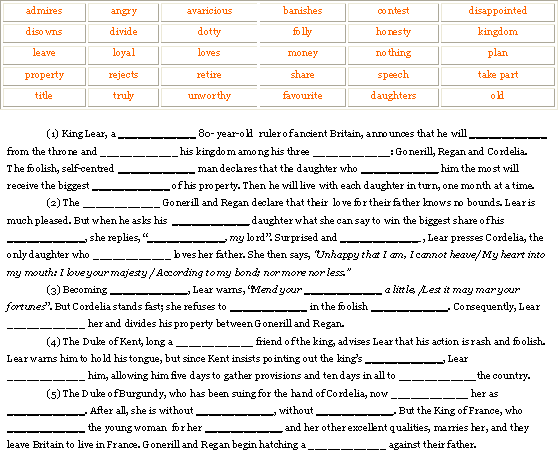
KEYS
(1) King Lear, a dotty 80- year-old ruler of ancient Britain, announces that he will retire from the throne and divide his kingdom among his three daughters: Gonerill, Regan and Cordelia. The foolish, self-centered old man declares that the daughter who loves him the most will receive the biggest share of his property. Then he will live with each daughter in turn, one month at a time.
(2) The avaricious Gonerill and Regan declare that their love for their father knows no bounds. Lear is much pleased. But when he asks his favourite daughter what she can say to win the biggest share of his kingdom, she replies, “Nothing, my lord”. Surprised and disappointed, Lear presses Cordelia, the only daughter who truly loves her father. She then says, Unhappy that I am, I cannot heave/ My heart into my mouth: I love your majesty/According to my bond; nor more nor less.
(3) Becoming angry, Lear warns, “Mend your speech a little, /Lest it may mar your fortunes”. But Cordelia stands fast; she refuses to take part in the foolish contest. Consequently, Lear disowns her and divides his property between Gonerill and Regan.
(4) The Duke of Kent, long a loyal friend of the king, advises Lear that his action is rash and foolish. Lear warns him to hold his tongue, but since Kent insists pointing out the king’s folly, Lear banishes him, allowing him five days to gather provisions and ten days in all to leave the country.
(5) The Duke of Burgundy, who has been suing for the hand of Cordelia, now rejects her as unworthy. After all, she is without money, without title. But the King of France, who admires the young woman for her honesty and her other excellent qualities, marries her, and they leave Britain to live in France. Gonerill and Regan begin hatching a plan against their father.
3) TEXT ANALYSIS (25 min. including oral check)
AIM: to guide students towards a deeper understanding of the text; to present the text in a stimulating and accessible form.
PROCEDURE: the teacher divides the class in small groups of three or four (different from the previous ones, so that each student has the opportunity to work with different partners). After handing out the chart - one per student- , he/she asks each group to look back at Text One, and find out quotations which convey each piece of information. After twenty minutes he/she calls for “stop” and gets a class feedback.
Look back at Text One, and find out how Shakespeare makes it clear what is happening. Find the words in the text which convey each piece of information. Complete the chart below.
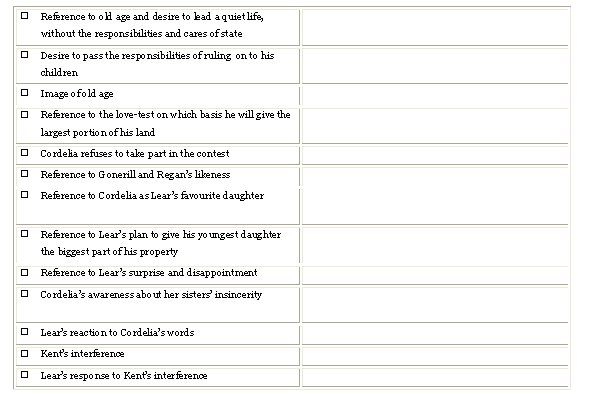
KEYS
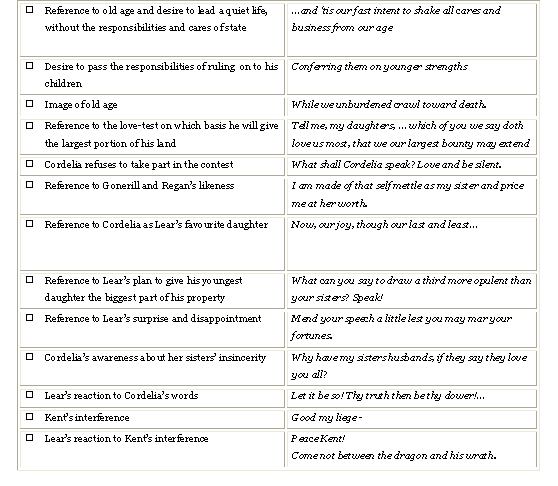
4) SPOTLIGHT ON LANGUAGE (30 min. including oral check)
AIM: to focus on Shakespeare’s language, to understand and appreciate the richness of Shakespeare’s words and expressions. PROCEDURE: Since this activity may be difficult for some students, the teacher uses mixed ability groups to discuss the questions. Using cooperative learning by assigning one task per group and then having students teach the class should encourage them to extend themselves beyond obvious answers. The teacher divides the class in four groups and gives them two different assignments on the same worksheet (task 1 and task 2). Groups A and B will work on task 1, whereas Groups C and D will work on task 2. After twenty minutes, groups A+B/C+D give a ten-minute lecture to their classmates, while the others take notes. As a result of this activity, all students will have the two tasks complete. The teacher circulates in the class, helping as required. Before doing the activity, it may be useful to revise the following literary terms:
Alliteration: it means ‘repeating and playing upon the same letter’. It is a figure of speech in which consonants, especially at the beginning of words, or stressed syllables, are repeated. It is a very old device indeed in English verse (older than rhyme) and is common in verse generally. It is used occasionally in prose.
Aside: in drama a few words or a short passage spoken in an undertone or to the audience. According to this theatrical convention the words spoken are inaudible to other characters on stage.
Assonance/Consonance: repetition of similar vowel/consonant sounds.
Blank verse: it was introduced by the Earl of Surrey in the 16th century in his translation of the Aeneid (c. 1540) and consists of unrhymed ten syllables alternating unstressed and stressed; properly, iambic pentameters. Surrey probably took the idea from the versi sciolti (free verse) of Molza’s Italian translation of the Aeneid (1539). It has become the most widely used of English verse forms and is the one closest to the rhythms of everyday English speech. This is one of the reasons why it has been particularly favoured by dramatists.
Dramatic irony: when the audience understand the implication and meaning of a situation on stage, or what is being said, but the characters do not. Common in tragedy and comedy.
Figurative language: language which uses figures of speech; for example: methaphor, simile and alliteration. Figurative language must be distinguished from literal language.
Metaphor: a figure of speech in which one thing is described in terms of another. It is the basic figure of poetry. A comparison is usually implicit; whereas in simile it is explicit.
Simile: a figure of speech in which one thing is likened to another. It is an explicit comparison recognizable by the use of the words ‘like’ or ‘as’. It is equally common in prose and verse and is a figurative device of great antiquity.
Note: the following worksheet is just an example. Students’ worksheets must be longer, with more space for answers.
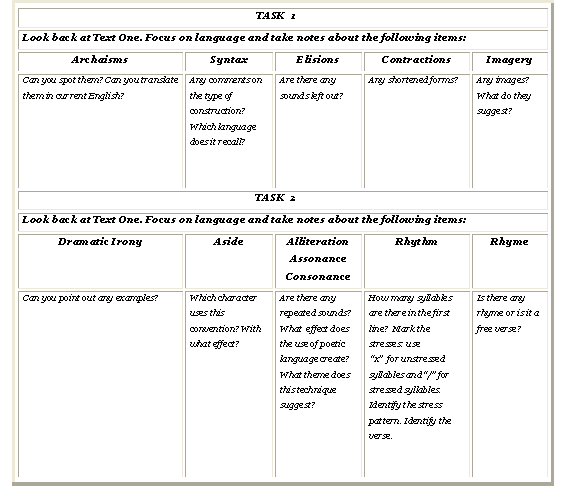
KEYS
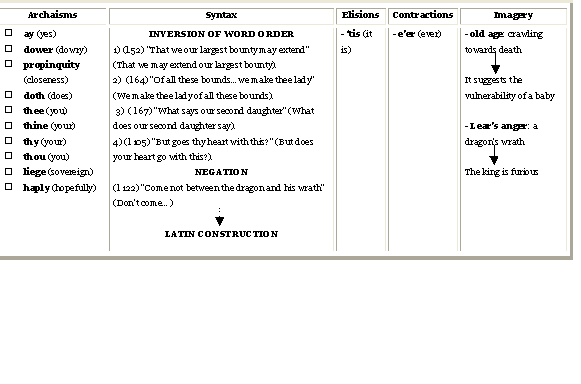
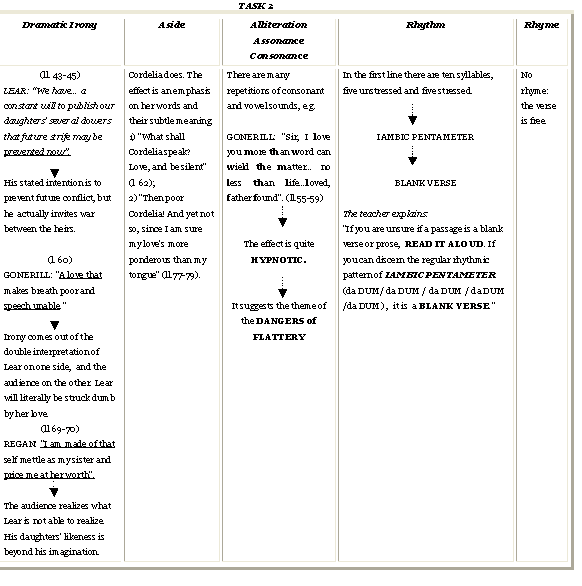
 3/11
3/11

|